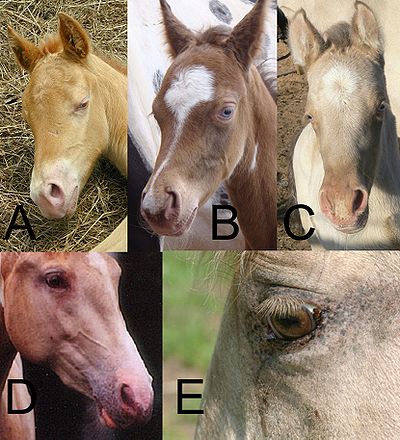Champagne (horse color)
As Champagne refers to the color of a horse passing through the Champagne gene was brightened. Depending on the underlying color, they are golden with a white or chocolate-colored mane or they have the typical champagne color with a slightly darker mane and tail.
Appearance
The coat often, but not always, has a metallic sheen. Black is faded to chocolate brown on the mane and tail and a little lighter on the body. Brown fur turns almost white in the mane and golden on the body. The fur of the foal is usually darker than it will be later in the adult animal.
Champagne horses are born with pink skin that has dark spots within the first few days of life. Adult animals still have pink skin with dark spots, but in areas exposed to the sun it darkens over the years. The foals' eyes are blue at birth, become lighter in the first few days of life and then darken over the years. Over time, they will take on a hazel brown or slightly greenish color.
Classic champagne
As a Classic Champagne , a black horse is called, by the Champagne gene was lightened. Sometimes it looks rather gray on the body, sometimes the color goes a little gray-brown. The mane and tail are darker than the body, but not black, but dark brown.
Can be mistaken for: The mouse fallow differs from the Classic Champagne in its dark brown eyes, the often two-tone mane with black medium hair and black skin.
Amber Champagne
Amber Champagne is a brown that is lightened by the Champagne gene. Its fur is golden in color, but it can never be so dark that the animal could be mistaken for a normal brown. The mane and tail are dark brown.
Sable Champagne is a black-brown that is lightened by the Champagne gene. Its fur is brown-gold in color. The mane and tail are also dark.
Possible confusion:
- Brown fallow : It is distinguished by its darker skin, darker eyes and two-tone mane, whose medium hair is black.
- Buckskin: Differs in its dark skin and mane.
Gold champagne
The Gold Champagne is a fox brightened by the gene. Its fur can be gold or a little lighter, but it never gets so dark that it could be mistaken for a fox with flaxes.
Can be mistaken for: Isabelle differs from Gold Champagne in its darker skin.
Lightened twice by Champagne
Horses that carry the Champagne gene twice have completely pink skin even as adult animals with less than half as many dark spots as heterozygous ones. Since both known cases are lightened foxes, it is unclear to what extent the appearance of the lightened brown and black horses differs from the yellowish-white of the double lightened foxes. Here, however, it is questionable whether the above cases did not arise from the combination of pearl and cream genes and not in interaction with the champagne gene. Since the latter is a dominant gene, no differences to the heterozygous carrier should be visible. See "Interaction".
Interactions with other genes

Races
The color champagne occurs in the following breeds: American Miniature Horse , American Quarter Horse , American Paint Horse , American Saddlebred , Appaloosa , Missouri Fox Trotter , Spanish Mustang , Spotted Saddle Horse , Tennessee Walking Horse , Half-breed Arabs. American Cream Draft Horses are foxes lightened by Champagne.
genetics
The Champagne gene (Ch c ) is located on chromosome ECA14 and is a mutation of the SLC36A1 gene (Solute Carrier 36 family A1), which is also PAT1 (proton / amino acid transporter 1) or LYAAT1 (lysosomal amino acid transporter 1) is called.
The gene encodes a transporter that transports amino acids and protons across membranes. This transporter is presumably responsible for setting the correct pH value for melanin production in the melanosome precursors. The lightened color of the affected horses is probably due to the fact that the pH value of the melanosomes in the horses with the mutation is incorrectly adjusted, which means that the melanin production does not work properly.
The lightening caused by the gene is inherited as an intermediary. This means that animals that carry the gene twice are slightly more lightened, have a lighter eye color and have fewer dark spots on their pink skin. However, the characteristics of the homozygous color overlap with the heterozygous expression and are difficult to distinguish, so that it is often said that the color is inherited dominantly.
See also
Web links
- Horse colors.eu
- English: Champagne Horses
- International Champagne Horse Registry - Sample images of horses of the color Champagne
swell
- DP Sponenberg, AT Bowling: Champagne, a dominant color dilution of horses. In: Genetics selection evolution. (Genet. Sel. Evol.) ISSN 0999-193X , 1996, vol. 28, no5, pp. 457-462 (11 ref.)
- D. Cook, S. Brooks, R. Bellone, E. Bailey: Missense Mutation in Exon 2 of SLC36A1 Responsible for Champagne Dilution in Horses. In: PLoS Genet . 2008 Sep 19; 4 (9), p. E1000195. PMID 18802473




